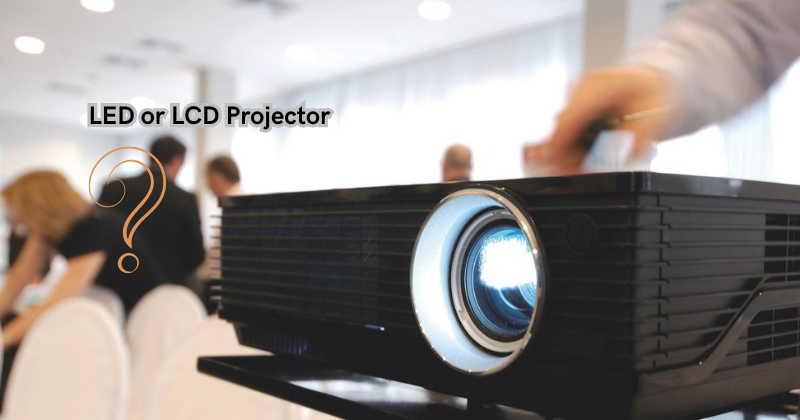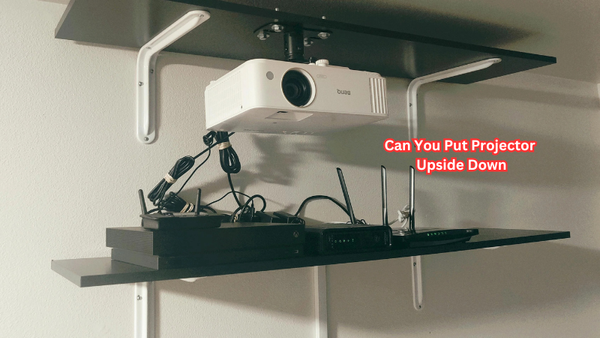Looking to elevate your presentations or movie nights?
LED and LCD projectors offer cutting-edge display technology that can transform any space into a captivating visual experience. LED projectors use light-emitting diodes to produce bright, vibrant images with superior color accuracy and energy efficiency.
On the other hand, LCD projectors employ liquid crystal displays to deliver sharp, high-resolution projections ideal for professional settings. Both projector types provide versatility, portability, and seamless connectivity, making them essential tools for business professionals, educators, and home entertainment enthusiasts.
Whether you're showcasing impactful visuals in a boardroom or creating an immersive home theater setup, LED and LCD projectors bring your content to life with unparalleled clarity and brilliance. Let's take a closer look at each type to determine which one is right for you.
What are LED Projectors?
LED projectors use an array of tiny light-emitting diodes to produce images. These diodes emit bright, focused light that is more efficient and long-lasting than traditional projector lamps.
The color accuracy and contrast created by LED projectors are also superior to other projection technologies, making them ideal for displaying photos, videos, and presentations with vibrant colors and crisp details.
Moreover, LED projectors have a longer lifespan than traditional lamp-based projectors, with some models boasting up to 20,000 hours of use. This makes them a cost-effective choice for long-term use and reduces the need for frequent bulb replacements.
What are LCD Projectors?
LCD(liquid crystal display) projectors work by splitting light into three beams - red, green, and blue - that pass through liquid crystal panels to create an image. The color and clarity of the projected image depend on the quality of the LCD(liquid crystal display) panels used.
Unlike LED projectors, which use individual diodes for each pixel, LCD projectors use a single bulb as their light source. LCD panel technology has advanced significantly in recent years, resulting in higher resolution and brighter projections.
LCD projectors are known for their high-resolution capabilities, making them a popular choice for professional presentations and large-scale events. They also offer a wide range of features, such as lens shift and keystone correction, that allow for more precise adjustments to the projected image.
LED or LCD Projector: Which One Should You Choose?
Choosing between an LED or LCD projector depends on your specific needs and preferences. Here are some factors to consider:
- Brightness: LED projectors are typically brighter than LCD projectors, making them a better choice for well-lit rooms.
- Color accuracy: As mentioned earlier, LED projectors have superior color accuracy compared to LCD projectors. For sharp and clear images, ambient light control is essential when using an LCD projector.
- Portability: LED projectors are smaller and lighter, making them easier to transport for on-the-go presentations or movie nights.
- Cost: While LED projectors may initially be more expensive, they offer a longer lifespan and lower maintenance costs compared to LCD projectors.
Ultimately, both LED and LCD projectors offer impressive display capabilities that can enhance your viewing experience. Consider your specific needs and budget to determine which one is the best fit for you.
Advantages of LED Projectors
LED projectors have become increasingly popular due to their many benefits. These include:
- Superior Color Accuracy: With LED technology, colors appear more vivid and accurate compared to traditional projectors. This is because LEDs emit RGB (red, green, and blue) light directly, while other projectors use filters to produce colors. This direct color emission results in a more vibrant and lifelike image.
- Energy Efficiency: LED projectors use up to 40% less energy than traditional lamp-based projectors, making them environmentally friendly and cost-effective.
- Longer Lifespan: With an average lifespan of 20,000 hours, LED projectors last much longer than conventional lamp-based projectors. This reduces the need for frequent bulb replacements and saves you money in the long run.
- Instant On/Off: LED projectors have no warm-up or cool-down time, allowing for immediate use and minimizing downtime during presentations or movie nights.
Advantages of LCD Projectors
LCD projectors also offer a range of advantages, including:
- High Resolution: LCD projectors can display high-resolution images and videos, making them ideal for professional presentations or large-scale events.
- Versatility: LCD projectors offer various features such as lens shift and keystone correction, allowing for more precise adjustments to the projected image. This makes them versatile and suitable for a wide range of settings.
- Lower Cost: LCD projectors are generally less expensive than LED projectors, making them more accessible to those on a budget. Now, LCD panels are more advanced and produce brighter and clearer images, making them an excellent value for their price.
LCD vs LED Display: Factors to Consider Before Making a Purchase
Before investing in either an LCD or LED projector, here are some factors to consider:
- Light Output: If you plan on using the projector in a well-lit room, consider an LED projector for its brighter output. For darker environments, an LCD projector may be sufficient.
- Resolution: Both projector types offer high-resolution capabilities, but LED projectors tend to have a slight edge in terms of clarity and sharpness.
- Image Quality: LED projectors are known for their superior color accuracy, while LCD projectors excel in contrast and black levels. Consider which aspect is more important to you when making your decision.
- Budget: LED projectors may initially be more expensive, but they offer long-term cost savings due to their longer lifespan. On the other hand, LCD projectors are generally more budget-friendly upfront but may require more maintenance and bulb replacements in the long run.
If you plan to purchase LCD projectors, make sure LCD projection technology offers superior color accuracy, energy efficiency, longer lifespan and instant on/off. On the other hand, LED projection technology provides high-resolution display capabilities, vivid colors, and energy-saving features.
Types Of Technology Used In Projectors
Aside from LED and LCD technology, there are other types of projectors available on the market. These include:
- DLP (Digital Light Processing): DLP projectors use tiny mirrors to reflect light onto a screen, creating an image. They offer excellent color accuracy and high contrast but may suffer from the "rainbow effect," where some viewers see flashes of red, green, and blue colors. DLP or LCD projectors are also available in 3-chip versions for improved color accuracy and brightness.
- LCoS (Liquid Crystal on Silicon): LCoS projectors use a combination of LCD and DLP technology to produce images. They offer high resolution, color accuracy, and contrast but can be more expensive than other projector types.
- CRT (Cathode Ray Tube): CRT projectors use traditional CRT television technology to display images. They offer high color accuracy and contrast but are bulky, expensive, and becoming increasingly obsolete in today's market.
- Laser Projectors: Laser projectors use laser diodes as their light source, resulting in a brighter and more efficient display compared to traditional lamp-based projectors. They also have a longer lifespan but can be more expensive upfront. Laser projector technology is becoming more popular due to its energy efficiency and low maintenance costs.
DLP projector or an LCD projector, it's crucial projection technology to choose one that meets your specific needs and preferences.
Disadvantages of LED and LCD Projectors
While both LED and LCD projectors offer impressive features, they also have some limitations to consider before making a purchase. These include:
- LED Projectors: Some disadvantages of LED projectors include higher upfront costs, the potential for motion blur in fast-moving scenes, and the possibility of color degradation over time.
- LCD Projectors: LCD projectors may experience a "screen door effect," where the image appears to have a visible grid, making it less transparent. They also tend to be bulkier and require more maintenance compared to LED projectors.
Ultimately, the choice between an LED or LCD projector will depend on your specific needs and budget. Consider the advantages and disadvantages of each technology to determine which one is the best fit for you.
4K LCD Vs 4K LED: What's The Difference?
Recently, there has been a rise in 4K projectors on the market. These projectors offer four times the resolution of standard HD projectors, resulting in incredibly sharp and detailed images. However, even within the 4K category, there are differences between LCD and LED technology to consider.
- Resolution: Both technologies offer 4K resolution capabilities, but LED projectors tend to have better pixel density, resulting in a more precise and defined image.
- Brightness: Generally, LED projectors offer higher brightness levels compared to LCD projectors, making them ideal for larger screens or well-lit environments.
- Color Accuracy: As mentioned earlier, LED projectors have an advantage when it comes to color accuracy. However, both technologies can offer impressive color reproduction in 4K.
- Price: 4K projectors, in general, tend to be more expensive than standard HD projectors. However, LED 4K projectors may have a higher price tag due to their advanced technology and features.
Ultimately, when choosing between a 4K LCD or LED projector, it's essential to consider the specific features and technologies used in each model to determine which one best suits your needs and budget.
FAQs
Which is better for your eyes LED or LCD?
Both LED and LCD projectors are safe for your eyes. However, some individuals may experience eye strain or fatigue when viewing a projector for extended periods. To avoid this, take breaks and adjust the brightness and contrast settings to suit your comfort levels.
Which is costly LCD or LED?
The initial cost of an LCD projector may be less expensive compared to an LED projector. However, in the long run, LED projectors offer cost savings due to their longer lifespan and energy-efficient technology. It ultimately depends on your budget and specific needs when choosing between the two.
What is a DMD in a projector?
DMD stands for Digital Micromirror Device, which is a critical component in DLP (Digital Light Processing) projectors. It is a microchip with thousands of tiny mirrors that tilt and reflect light to create an image on the screen.
Conclusion
In conclusion, LED and LCD projectors stand as pillars of modern visual display technology, offering unparalleled versatility and performance across various domains. Whether in professional presentations, educational environments, or home entertainment setups, these projectors elevate the viewing experience with their vibrant imagery, sharp resolution, and seamless connectivity.
The energy-efficient nature of LED projectors makes them an eco-friendly choice, while LCD projectors excel in delivering high-quality, detailed projections. Their portability and user-friendly features make them indispensable tools for individuals and businesses looking to make a lasting impression.
Embracing the advancements in LED and LCD projection technology ensures that your visual content is delivered with striking clarity and brilliance, captivating audiences and leaving a lasting impact. Step into the future of graphical display with LED and LCD projectors, where innovation meets excellence.





